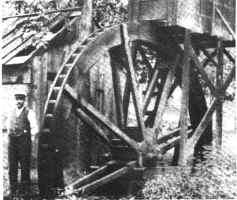LCC Courses
Announcements:
Econ 120 students, for the final
exam:
Consult the Updated
May 6: NEW Final Exam Study Outline ,
**check back over the next few
days for updates to the above material**
Econ 120 Power, Authority and Exchange
Recently Added/Updated:
Updated May 6: NEW Final Exam Study Outline
Econ 213 American Economic History

Click here to see a large picture of this waterwheel
The water wheel constituted a major advance
in the material betterment
of the human race. More generally, it
marked the transition from doing work
by applying human and animal muscle power
to doing it by harnessing
the forces of nature (e.g. the energy of swift
moving or falling water).
Although the Romans were using water-powered
mills for grinding wheat
into flour as early as the first century A.D.,
it was not until the 10th century
that western Europe began to make extensive
use of them.
Water-power mills were used extensively in
Europe, America,
and elsewhere into the late 19th century --
for grinding wheat and other
grains into flour, fulling wool, operating
bellows for blast furnaces,
and powering textile mills and numerous other
factories.